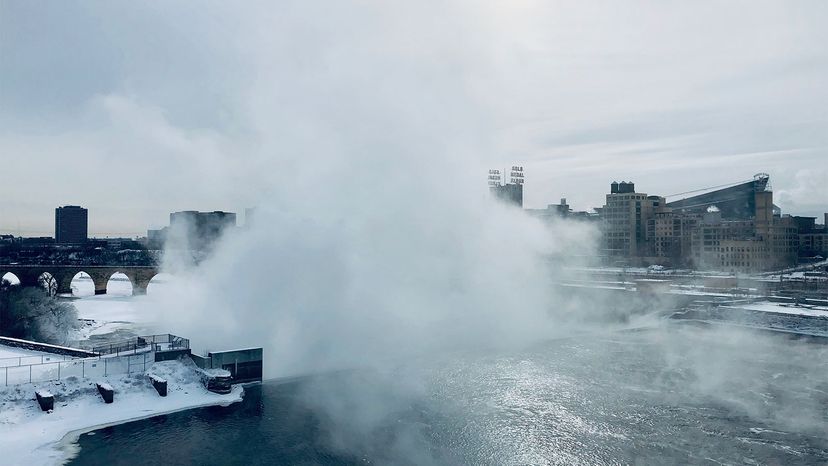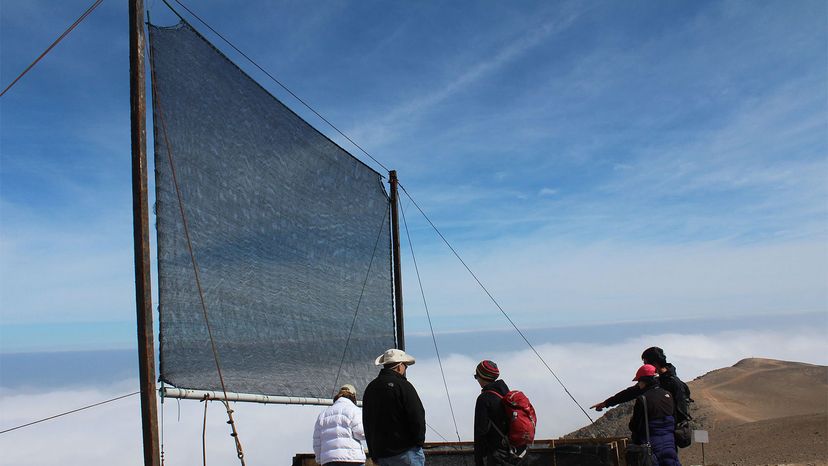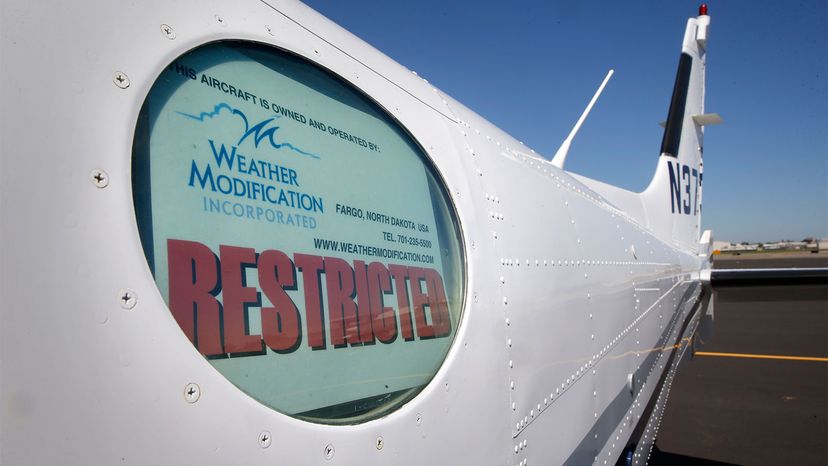
Water is becoming an increasingly important issue in the developed world. But this issue is nothing new for other, less developed nations. For centuries, clean drinking water has been hard to come by for many populations, especially those in impoverished nations. In some areas, water may be available, but it’s often disease-ridden, and drinking it can be fatal. In other areas, a viable water supply is simply not available at all.
According to the World Health Organization, more than 2 billion people live in water-stressed countries, and that number is expected to increase in some regions because of climate change and population growth. This leads us to wonder: Since the world needs clean water so badly, why can’t we just make it?
Water is made of two hydrogen atoms attached to an oxygen atom. This seems like pretty basic chemistry, so why don’t we just smash them together and solve the world’s water ills? Theoretically, this is possible, but it would be an extremely dangerous process, too.
To create water, oxygen and hydrogen atoms must be present. Mixing them together doesn’t help; you’re still left with just separate hydrogen and oxygen atoms. The orbits of each atom’s electrons must become linked, and to do that we must have a sudden burst of energy to get these shy things to hook up.
Since hydrogen is extremely flammable and oxygen supports combustion, it wouldn’t take much to create this force. Pretty much all we need is a spark — not even a flame — and boom! We’ve got water. The hydrogen and oxygen atoms’ electrons’ orbits have been conjoined.
But we also have an explosion and — if our experiment was big enough — a deadly one. The ill-fated blimp, the Hindenburg, was filled with hydrogen to keep it afloat. As it approached New Jersey May 6, 1937, to land after a trans-Atlantic voyage, static electricity (or an act of sabotage, according to some) caused the hydrogen to spark. When mixed with the ambient oxygen in the air, the hydrogen exploded, enveloping the Hindenburg in a ball of fire that completely destroyed the ship within half a minute.
There was, however, also a lot of water created by this explosion.
To create enough drinking water to sustain the global population, a very dangerous and incredibly large-scale process would be required. Still, more than a century ago the thought of an internal combustion engine — with its controlled repeated explosions — seemed dangerously mad. But as water becomes scarcer, the process of joining hydrogen atoms to oxygen atoms may become more attractive than it is currently. Necessity, after all, is the mother of invention.
But there are safer ways of creating water out of thin air, and projects to do just that are already underway.
Creating Water From Thin Air

There’s water around us all the time, we just can’t see it. The air in our atmosphere contains a varying amount of water vapor, depending on the weather. When it’s hot and humid, evaporated water can make up as much as 6 percent of the air we breathe. On cold, dry days it can be as low as .07 percent of the air’s makeup.
This air is part of the water cycle, an Earth process. Crudely put, water evaporates out of rivers, lakes and the ocean. It’s carried up into the atmosphere, where it can collect into clouds (which are actually just accumulations of water vapor). After the clouds reach the saturation point, water droplets will form, which we know as rain. This rain runs off the land and collects into bodies of water, where the whole process begins again.
The problem is, the water cycle goes through dry periods. Because of this, some inventors have begun to wonder, why wait? Why not pull the water vapor right out of the air?
Well, some have done just that. Here’s a look at some of the latest technologies for creating water out of thin air.
Aquaer
Enrique Veiga, an 82-year-old Spanish engineer, invented a drinking water extractor that uses electricity to cool air until it condenses into water. It’s the same effect that causes condensation in air conditioning units.
He’s not the first person to use this technology, but his company, Aquaer, is the first to work in temperatures above 104 degrees Fahrenheit (40 degrees Celsius) and humidity as low as between 10 and 15 percent. In other words, his machine can make water in the desert, which happens to be the kind of place where people need water the most.
After perfecting the machine, Aquaer was commissioned to supply drinking water to areas of Namibia and in a refugee camp in Lebanon. Veiga founded a nonprofit, called Water Inception, with a vision to distribute his water-making machines to more refugee camps and other dry parts of the world.
Whisson’s Windmill
Australian inventor Max Whisson is using another approach. His Whisson Windmill uses wind power to collect water out of the atmosphere. In 2018, he told the Australian Broadcasting Corporation that water vapor amounts to about “10,000 billion litres [about 2,600 billion gallons] in the bottom kilometere [about .62 miles] of air around the world.” And all of this water is replaced every few hours as part of the water cycle.
Whisson’s windmill uses refrigerant to cool the blades of his mill, which he’s named Max Water. These blades are situated vertically rather than diagonally, so that even the slightest breeze turns them. The blades cool the air, causing water vapor to condense and become liquid water again. This condensation is then collected and stored. Whisson’s windmill can collect as much as 2,600 gallons (9,842 liters) of water from the air per day.
Whisson said that his biggest challenge isn’t the engineering behind his invention but finding the venture capital to back it.
Tsunami Products’ Atmospheric Water Generator
Tsunami Products, a Washington-based company operating out of California, has developed a device for creating water that works similarly to an air conditioner. It dehumidifies air, extracts water vapor and then filters it so it’s ready for drinking.
According to Tsunami Products, the device works by drawing air “through a series of condensing coils, where water vapor is cooled down sufficiently to reach the dew point. This converts water vapor into droplets.” The converted water is then filtered for any contaminants, such as pathogens and pollen, and collected in a storage tank ready for tapping.
Fog-harvesting Machines
The higher the relative humidity, the more water there is in the air to capture. Considering fog occurs when relative humidity is nearly 100 percent, you would think that researchers would try extracting water from fog. And you would be right.
Fog-harvesting machines have been around for years and, as logic would suggest, work best in foggy climates such as coastal and mountainous regions. These relatively low-cost collection systems resemble volleyball nets with a fine mesh like a window screen. The screens capture water when wind blows through. Unfortunately, water droplets can clog the screens, preventing the wind from passing through, thus preventing the device from collecting water.

To improve upon this design, Jonathan Boreyko, who heads up the Nature-inspired Fluids and Interfaces Lab at Virginia Tech, took a cue from Mother Nature. He studied how giant sequoia trees collect water from fog on their needles, which run parallel to the ground. As the water collects on the needles, it then rolls downward and drips onto the ground essentially watering the tree’s roots.
Based on this insight, Boreyko’s lab designed small, lab-scale fog-harvesting “harps” with horizontal collection wires to simulate giant sequoia needles. This method resulted in a water harvest from fog three times greater than similar-sized systems using vertical wires.
Drinkable Air
Several companies currently sell water-from-air machines, such as Florida-based Drinkable Air. The company uses “atmospheric water generator technology” to pull air through an electrostatic-antimicrobial filter intended to remove airborne particles. A condensation unit receives the clean humid airflow and condenses water vapor into liquid. As the machine collects water, the water “drops into a collection tank where it is ozonated to keep the water pure and fresh,” according to the company’s website. The machine further chills and filters the water before adding minerals to increase the pH level and improve the taste.
Drupps
And then there’s Drupps, a spinoff of humidity-control company Airwatergreen. It uses a completely different water-collecting technology that relies on a liquid desiccant to pull moisture from the air. The slurry is then heated and the water is boiled off, cooled and collected. While cost effective, there are some drawbacks. As with condenser-style water collection systems, Drupps’ technology is energy intensive and thus less kind to the Earth.
Speaking of the environment, why go to the trouble of collecting water out of the air? Why not simply cause more rain to fall? It may sound far-fetched, but this is actually done — at times, with catastrophic consequences.
Cloud Seeding and the British Disaster

It turns out humans can be rain makers, too, thanks to a weather modifying technique known as cloud seeding. It involves artificially adding condensation nuclei (tiny, suspended particles upon which water vapor condensation begins) to the atmosphere that provide a base for snowflakes or raindrops to form and fall down to Earth.
Cloud seeding can be done by burning a small amount of silver iodide from ground-based generators or releasing the chemical into the air by aircraft. This was done March 15, 2022, in California’s Central Valley by the Sacramento Municipal Utility District (SMUD) to increase snowpack and streamflow along the Upper American River in an effort to produce more hydroelectric power.https://www.youtube.com/embed/s2j4WEvrJbs
There are definite benefits to cloud seeding, such as increasing mountain snowpack and supplementing the natural water supply availability. But it can also have more questionable uses, sometimes with negative results.
In an effort to prevent rain during the opening ceremonies of the 2008 Beijing Summer Olympics in Beijing, China used cloud seeding, which works by firing silver iodide into storm clouds, in the days leading up to the event. The Chinese government hoped it could essentially “use up” the existing clouds and assure clear skies for the ceremony.
The country’s been doing it for decades — with positive results. But another experiment in cloud seeding, on the other side of the Eurasian land mass, didn’t go so smoothly.
Following World War II, the British government was still looking at ways to get a leg up over enemy militaries. The Nazis had come close to destroying Britain, and the United Kingdom had developed a taste for preparation. The British government looked to the skies for an advantage. The Royal Air Force (RAF) began experimenting with cloud seeding. By impregnating the clouds with the particles needed to create a severe thunderstorm, the British could effectively thwart the movement of troops and even literally rain out enemy advances. But the cloud-seeding project went terribly awry.

It’s not that the experiments with cloud seeding didn’t work. It worked too well.
In 2001, the British Broadcasting Corporation (BBC) investigated rumors that the RAF had seeded the clouds over England. They turned up first-person accounts of some of the pilots who were involved in a top-secret mission called “Operation Cumulus.” During this August 1952 operation, RAF pilots flew above the cloud line, dropping payloads of dry ice, salt and — like the Chinese currently use — silver iodide.
After just 30 minutes, rain began to fall from the infected clouds. At first, the RAF pilots — dubbed “rainmakers” by the press — reputedly celebrated their success. But within the week a deluge began. By the end of the month, North Devon, an area of England near the site of the cloud-seeding experiment, experienced 250 times the normal amount of rainfall.
On Aug. 15, 1952, the day the rain started, an estimated 90 million tons (82 million metric tons) of water coursed through the town of Lynmouth in just one day. Entire trees were uprooted, forming dams and allowing the tide of the two rivers flowing through Lynmouth to grow even stronger in force. Boulders were carried by the current, destroying buildings and carrying residents into the sea. In all, 35 Britons lost their lives that day as a result of the torrential rain. Britain’s Ministry of Defense maintains that it had not experimented with cloud seeding before the Lynmouth incident.
China and Britain paint two versions of the same picture. On one hand, the Asian nation has successfully created a cloud-seeding program. They’ve managed to generate irrigation for arid croplands from the ultimate source. But the British disaster shows the potential results of toying with the forces of nature.
And still, we need water more than ever. Using explosions isn’t viable to produce water currently, and current water-collecting methods aren’t being produced on a large enough scale to help with the growing need for water. Water is a finite resource, and one life on Earth can’t do without.
~Originally published 2007
Nature is the best for needed rain. However, when lack of precious water
Becomes evident mankind must do whatever it takes to make water available.
Governments using science to help out. We can and will provide all the necessities. Just ponder about the James Webb telescope and anyone who doubts the ability of science through education and PRAYER 🙏 be degenerates. It’s the American way. With leadership.
Let me just get straight to the point; I saw your blog and I think you would be a great fit for our company :-). We are currently paying upwards of $70/hour for English translators. We are looking for people who are reliable, hardworking, and willing to work long-term. English fluency is preferred, and I don’t think you should have any problems with this requirement. We are an online based company from North Carolina. Interested? Apply here: https://msha.ke/freedomwithtay
Okay, this might be a little bit random, but I saw your blog and had to ask, are you interested in a translation job? I know I’m a stranger but I felt like doing a good deed today by alerting a couple people that a good position has opened up here: https://msha.ke/freedomwithtay and they pay sometimes even $70/hour. Okay, they won’t always give that amount, I only made around $400 last week, but it’s part time and when times are tight, every little bit helps. Hope it helps, and my apologies if you’re not interested. Have a great day/evening!
Hey, honestly your site is coming along :-), but I had a question – it’s a bit slow. Have you thought about using a different host like propel? It’d help your visitors stick around longer = more profit long term anyway. There’s a decent review on it by this guy who uses gtmetrix to test different hosting providers: https://www.youtube.com/watch?v=q6s0ciJI4W4 and the whole video has a bunch of gold in it, worth checking out.
Hey, honestly your site is coming along :-), but I had a question – it’s a bit slow. Have you thought about using a different host like propel? It’d help your visitors stick around longer = more profit long term anyway. There’s a decent review on it by this guy who uses gtmetrix to test different hosting providers: https://www.youtube.com/watch?v=q6s0ciJI4W4 and the whole video has a bunch of gold in it, worth checking out.